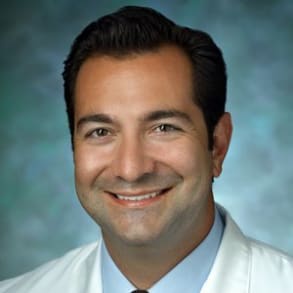Pediatric general surgeon Clint Cappiello and pediatric gastroenterologist Kenneth Ng discuss the ERCP/ laparoscopic cholecystectomy procedure at Johns Hopkins Children’s Center. In this video, they answer a variety of questions, including the process for the procedure, patients who should be referred and the recovery period.
Typically, patients undergo the procedure in the operating room. It's a joint operation where the patients already met. Our G I team, the surgical team, our anesthesiologist and radiologist. And so once you've made a diagnosis of an obstructing biliary stone, they're brought to the operative theater for a combined approach to management. So after they're completely asleep, our G I colleagues will start with the endoscopy to evaluate the ducts using a camera and wires to remove any impacted stones. We can simultaneously place our instruments in to facilitate if need be using a wire or other endoscopic techniques to improve access to the biliary tree. And once the tree has been swept, clean and the obstruction removed, we then proceed to do the gallbladder removal or cholecystectomy. At the same time, once the patient is asleep with support from pediatric anesthesia, uh our G I team will go in endoscopically and we perform a procedure called er CP, which stands for endoscopic retrograde cholangiopancreatography. In this procedure, we use our device to cannulate the common bile duct, which in this example has an obstructing stone. Our goal is to remove this obstructing stone. Thus allowing the surgeons to then come in laparoscopically to perform a cholecystectomy. Any patient who presents with a known history of gallstones and biliary obstruction from a stone impacted in the common bile duct or choledocholithiasis would benefit from this intervention. Historically, this was done in two settings and now we can do it in one as a multidisciplinary approach where we no longer have to space out the, er CP and the cholecystectomy at two separate anesthetic events. So, most commonly we take care of patients who present with gallstone pancreatitis. But the reason why they have pancreatitis is because there's a stone obstructing the lower common bile duct where the pancreas main duct also merges with the common bile duct. The origin of the stones usually is due to a collection of stones in the gallbladder. So we usually take care of patients with a combination of gallstones along with an obstructing common buc stone patients should be referred with a history of gallstones or gallstone pancreatitis or even in the acute setting where they have cidal with thesis with or without pancreatitis. And so patients who require endoscopic management of biliary obstruction from a stone and then subsequent gallbladder removal should be referred to our center for management by a pediatric team. Patients with common bic stones and gallstones usually would qualify and benefit from this combination procedure. This is a truly multidisciplinary approach to pediatric care. And so the typical index consultation is either with a surgeon or a gastroenterologist once both teams have met the patient and the necessary lab work and imaging is done, we then will coordinate our care with our intraoperative fluoroscopy team. Pediatric anesthesiologist and our general pediatricians to provide sort of a 360 care for the patient, both preoperatively, intraoperatively and postoperatively. This is a partnership between pediatric G I, pediatric surgery, pediatric anesthesiology along with members from radiology including the fluoroscopic text. The recovery for both procedures is typically just an overnight stay. The benefit of this combined approach is that you no longer have to add those two procedures in series. So where an er CP is done and then the patient recovers and then subsequently goes to the operating room. Three or four days later, we now do it in one visit. So barring any complications, all procedures are done at the same time, the patient has their definitive management, which is gallbladder removal and they can usually go home within 24 hours. The patients generally do very well and some can be discharged the following day. Those who have had pancreatitis may require a longer stay so that we can ensure that the pancreatitis results. Patients should come to Johns Hopkins because it's a truly pediatric focused center of excellence. Everybody that takes care of these patients is pediatric trained. You're not gonna get an adult endoscopist or a part time pediatric surgeon or a rotating anesthesiologist. Everybody here is focused on pediatrics. It's also rare to have gastroenterologists in the pediatrics field, who have advanced training in endoscopy like er CP. And so you're guaranteed that your child is gonna have care by a pediatric surgeon, a pediatric gastroenterologist, pediatric anesthesiologist, and radiologist, who are trained in the lowest possible dosing of radiation to accommodate definitive care for this patient. We are one of the few programs in the country that offers this combination procedure of er CP and laparoscopic cholecystectomy. We are the only program in this region that offers a service and we take great pride in making sure that we can provide precision medicine for our patients.




